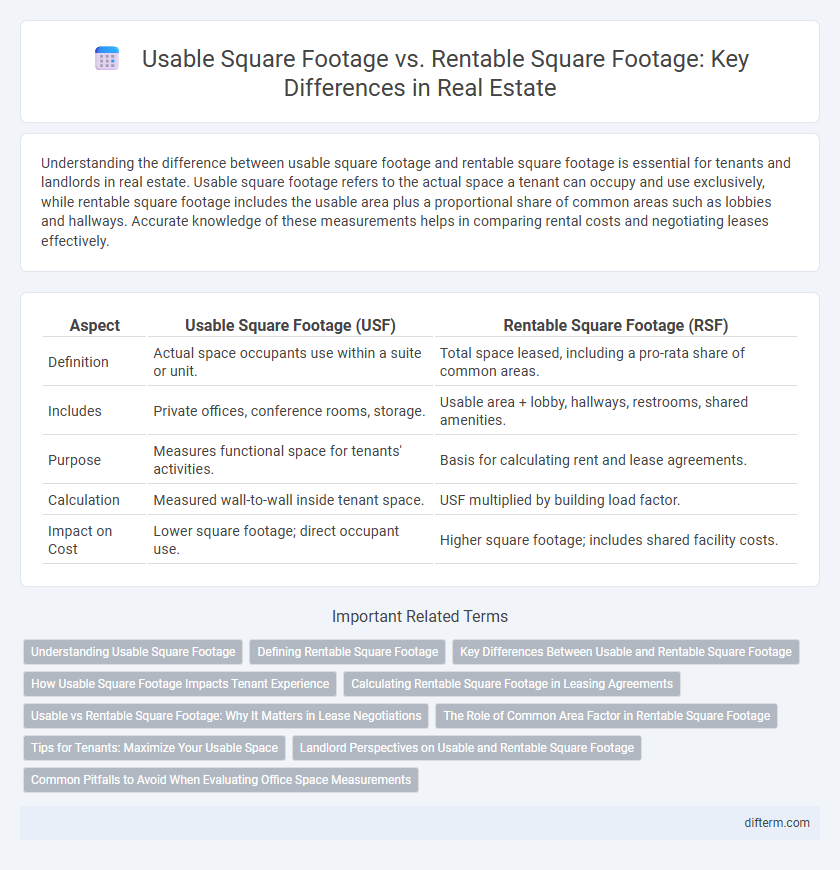Understanding the difference between usable square footage and rentable square footage is essential for tenants and landlords in real estate. Usable square footage refers to the actual space a tenant can occupy and use exclusively, while rentable square footage includes the usable area plus a proportional share of common areas such as lobbies and hallways. Accurate knowledge of these measurements helps in comparing rental costs and negotiating leases effectively.
Table of Comparison
| Aspect | Usable Square Footage (USF) | Rentable Square Footage (RSF) |
|---|---|---|
| Definition | Actual space occupants use within a suite or unit. | Total space leased, including a pro-rata share of common areas. |
| Includes | Private offices, conference rooms, storage. | Usable area + lobby, hallways, restrooms, shared amenities. |
| Purpose | Measures functional space for tenants' activities. | Basis for calculating rent and lease agreements. |
| Calculation | Measured wall-to-wall inside tenant space. | USF multiplied by building load factor. |
| Impact on Cost | Lower square footage; direct occupant use. | Higher square footage; includes shared facility costs. |
Understanding Usable Square Footage
Usable square footage refers to the actual area within a leased space that tenants can occupy and use exclusively, excluding common areas such as hallways, lobbies, and restrooms. This metric is critical for businesses to accurately assess the functional workspace available for their operations and personnel. Understanding usable square footage helps in calculating real costs and optimizing office layouts for efficiency and comfort.
Defining Rentable Square Footage
Rentable square footage includes the usable square footage of a tenant's space plus a proportional share of common areas such as lobbies, hallways, and restrooms. This measurement is crucial for calculating lease costs, as landlords charge rent based on rentable square footage rather than just the usable floor space. Accurate understanding of rentable square footage ensures tenants are aware of the total area they are financially responsible for in a commercial lease.
Key Differences Between Usable and Rentable Square Footage
Usable square footage refers to the actual space tenants can occupy and use within a property, excluding common areas like lobbies, hallways, and restrooms. Rentable square footage includes both usable space and a proportional share of common areas, which landlords use to calculate lease payments. Understanding the distinction is crucial for accurate rent pricing, lease negotiations, and comparing property costs.
How Usable Square Footage Impacts Tenant Experience
Usable square footage directly influences tenant experience by defining the actual space available for daily activities, impacting comfort and productivity. Tenants prioritize usable space for furniture layout, movement, and workspace efficiency, which rental agreements often obscure with rentable square footage figures that include common areas. Clear understanding of usable square footage enables tenants to better assess value, optimize office design, and enhance satisfaction within leased commercial properties.
Calculating Rentable Square Footage in Leasing Agreements
Calculating rentable square footage in leasing agreements involves adding the usable square footage of a tenant's space to a proportionate share of common areas, such as lobbies, hallways, and restrooms. This total rentable area is used to determine the tenant's rent and is defined by the building's load factor or common area factor. Understanding the difference between usable and rentable square footage ensures accurate lease pricing and fair allocation of shared building expenses.
Usable vs Rentable Square Footage: Why It Matters in Lease Negotiations
Usable square footage refers to the actual space tenants occupy, while rentable square footage includes usable space plus a proportional share of common areas like lobbies and hallways. Understanding the distinction is crucial in lease negotiations, as tenants often pay rent based on rentable square footage, impacting overall lease costs. Accurately assessing usable versus rentable square footage ensures fair pricing and helps tenants optimize their leased space for operational efficiency.
The Role of Common Area Factor in Rentable Square Footage
Rentable square footage includes usable square footage plus a proportional share of common areas such as lobbies, hallways, and restrooms, which is quantified by the common area factor (CAF). The common area factor is expressed as a percentage that increases the usable square footage to reflect the tenant's total rental cost for the space used plus access to shared facilities. Understanding the role of CAF is critical for tenants and landlords when calculating lease expenses and comparing commercial real estate spaces.
Tips for Tenants: Maximize Your Usable Space
Tenants should focus on understanding the distinction between usable square footage, which represents the actual space they occupy, and rentable square footage that includes a proportionate share of common areas, to make informed leasing decisions. Prioritize leasing spaces with higher usable-to-rentable ratios to maximize functional workspace and reduce costs associated with unused common areas. Request detailed floor plans and compare the efficiency of potential spaces to optimize layout and workflow, ensuring every square foot contributes to your business operations.
Landlord Perspectives on Usable and Rentable Square Footage
Landlords prioritize rentable square footage as it determines the total leaseable area used to calculate tenant rent, encompassing usable space plus common areas like lobbies and hallways. Usable square footage reflects the actual tenant-occupied area, influencing tenant satisfaction but not directly affecting rental income. Accurate measurement and clear communication of these metrics help landlords maximize revenue while managing tenant expectations effectively.
Common Pitfalls to Avoid When Evaluating Office Space Measurements
Misunderstanding the difference between usable square footage (USF) and rentable square footage (RSF) can lead to overestimating the actual office space available, as RSF includes common areas like lobbies and restrooms that are not exclusively usable. Tenants often overlook load factors, which allocate a portion of shared spaces to individual offices, resulting in higher rent costs based on RSF rather than USF. Accurate evaluation requires reviewing lease agreements carefully to identify these measurement methodologies and avoid unexpected expenses.
Usable Square Footage vs Rentable Square Footage Infographic

 difterm.com
difterm.com